Ontario Place
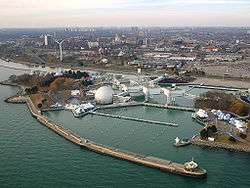
Ontario Place is a park and former theme park in Toronto, Ontario. The grounds are located on the shore of Lake Ontario, south of Exhibition Place and southwest of Downtown Toronto. It opened on May 22, 1971 and consists of three artificially constructed landscaped islands.
The grounds are owned by the Government of Ontario and is administered as an agency of the Ontario Ministry of Tourism and Culture. It is planned for redevelopment by the City of Toronto since the closure of the theme park. Currently the site is home to the Budweiser Stage, a marina, and the geodesic dome that contains the Cinesphere, the world’s first IMAX theatre.
History (Ontario Place theme park)
The Ontario Place theme park was an entertainment and exhibition complex located in Toronto, Ontario, Canada. It operated annually during the summer months from 1971 until 2011.
Designed originally to promote the Province of Ontario through exhibits and entertainment,[1] its focus changed over time to be that of a theme park for families with a water park, a children's play area, and amusement rides. Exhibits in the pods were discontinued and the building became a venue for private events. The concert stage was turned over to a private concert operator and rebuilt as the Amphitheatre. After a long period of declining attendance, the Government of Ontario closed the facility except for its music venue and marina. It plans to re-open the facility after redevelopment into a year-round multiple-use facility.
Background
Built in 1926, the CNE Ontario Government Building displayed exhibits about Ontario at the annual Canadian National Exhibition (CNE). After the success of Expo 67 in Montreal, the Government of Ontario decided to replace the facility with a new state-of-the-art showcase.
a new focal point for our province.... a new attitude to our lakefronts.... a new showcase for our province and people.

The park itself was originally conceived as an onshore exhibit, but this idea was discarded in favour of five large, architecturally unique, three-level Pods. Each Pod would be approximately 8,000 square feet (743 m²) in area, and suspended by steel cables from four large central pylons driven deep into the lake bed. These Pods would initially house various Ontario-themed exhibits in an aquatic setting somewhat similar in concept to Montreal's Expo 67 grounds (which were in the middle of the Saint Lawrence River).
Design and construction
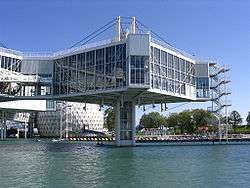
During the design phase, a difficult design problem developed. The cost of the open-water Pod foundations alone (at the time, estimated at C$9 million) would consume almost the entire budget for the Pods' construction. Architect Eb Zeidler was faced with a dilemma: how to construct the Pods without the necessary budget. Zeidler developed an innovative solution: after a trip to the Caribbean, he realized that a "barrier reef" concept would cut down on wave action from the lake enough to reduce the cost of the Pods' foundation to 1/10 of the original open-water estimate. After some quarrels with the Toronto Harbour Commission (due to the dangers of the unseen reef to shipping), the reef plan was modified to incorporate three artificial "barrier islands" made from city landfill. Ironically, the barrier islands were to be so well crafted, they became an integral part of the Ontario Place experience.
The five steel and aluminum pavilion pods are square with 88-foot (27 m) sides. The pods are supported on four pipe columns, rising 105 feet (32 m) above the lake. Tension cables support the short-span trusses. They sit on concrete filled caissons, driven 30 feet (9.1 m) into the lake's bedrock. Each of the pavilions is connected to one another and the land by glazed steel bridges. Ontario Place was designed to have a modular use and appearance. Zeidler says that the structures were designed to "give an illusion of dimensionless space, exploiting technology to shape the society of tomorrow." [3]
The Forum, an outdoor concert venue, was featured on a central hub-island, while a children's village would occupy an eastern island. A commercial section overlooked the water, with modular construction for shops and restaurants to the west. All would be connected by an intricately planned set of walkways and bridges. In addition, each island would have a unique colour scheme, and the entire complex was later infused with the brilliant colours and graphic design that were typical of the late 1960s and early 1970s. The children's village was designed by Eric McMillan.
The Forum theatre sat 3,000 and had additional grass 'seats'. The roof structure was a hyperbolic paraboloid positioned on cement bastions. It covered a 68-foot (21 m) revolving stage, giving near 360 degree sightlines. The roof was made out of tongue and groove plywood, covered by copper sheathing.
Landscape architect Michael Hough overlaid a scale model of the University of Toronto's excellent walking paths onto the Ontario Place plans to check for appropriate walking distances. This ensured that comfortable rest areas were placed appropriately, so that children and the elderly would not need to walk too far without a comfortable seat. Soon after opening in 1971, a rubber-wheeled tractor train was used to take visitors between key points on the various islands, though this has long since been discontinued.
Prevailing wind and wave conditions were also considered in the design, a scale model of which was tested in the University of Toronto's wind tunnel. Large earthwork berms planted with tall native Ontario trees were created to shelter walkways from the prevailing southwesterly winds.
To the south, a cost-effective and theme-congruent plan to sink three large obsolete Great Lakes shipping vessels was implemented, which sheltered the artificial harbour from intense open-lake waves. (The same technique would later be used on Toronto Island and the Outer Harbour.) The first phase of construction was the sinking of the ships onto a stone bed, then covered in concrete forming a 1,500-foot (460 m) long breakwater. Once the perimeter was finished, work began on the 50 acres (20 ha) of the three artificial islands.
There was originally some controversy about allowing a public facility to house an upscale boating dock within the new artificial harbour. However, supporters of the plan believed that the dock's integration into Ontario Place would tie the location closer to the lake via boating activity, and improve the general ambiance.
At Expo 67, the new IMAX movie technology was first exhibited. A great success, it was decided to build the first permanent IMAX installation at Ontario Place. The Cinesphere, an 800-seat theatre, was built. Its building is a 'spherical triodetic dome', with a 61-foot (19 m) outer radius, and a 56-foot (17 m) inner radius. The dome is supported by prefabricated steel aluminum alloy tubes. The final cost of construction was CA$29 million ($181 million in 2017 dollars)[4].[5]
Promotion
To commemorate the opening of the theme park and promote the province of Ontario, a multi-media exhibition was created and presented inside the pavilion. Dolores Claman wrote the music and Richard Morris wrote lyrics for the music to this presentation, entitled "Theme from Ontario Place". "Theme from Ontario Place" was subsequently released by the Ontario Department of Trade and Development as a double sided 45 manufactured by Quality Records (OP1971), side A containing a "Pop" version and Side B an "Easy Listening" recording. A photo of the still under construction Ontario Place was used on the cover.
Changes over time
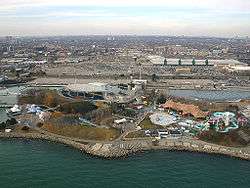
The park was altered considerably since its inception. Redevelopment occurred on all three islands of the park; the pod buildings themselves were eventually closed to exhibit space and rented out as the "Atlantis" private event facility.
In the 1980s, the west island was redeveloped with the "Ontario North Now" exhibit being installed to showcase Northern Ontario. It was a combination of inter-connected silo-like buildings, topped with domes reminiscent of the Cinesphere, connected by overhead walkways, and a smaller domed movie theatre. A boat-based water ride was added, along with a smaller exhibition center consisting of three concrete silo-like buildings. A large reflecting pool nearby was drained and used to house the addition of a major "climber" structure, a smaller stage for kids shows and several other kid-oriented attractions, reducing the complete separation of areas that had been featured in the original design.
The popular outdoor concert stage, The Forum, was torn down in the mid-1990s and replaced with the Molson Canadian Amphitheatre, a much larger facility based on a bandshell design. An additional "Echo Beach" outdoor music venue was added to the north shore of the east island.
On the east island, the original children's area, which was primarily "non-powered", has largely been removed. The large wood-and-rope climber area was replaced with the large "Soak City" waterpark, the first water park in Ontario. Several small fair-ground rides were later added. The large tension structure tent that covered most of the children's park was removed in 2009/10, leaving a large open area with a new stage. Many of the concrete bollards used to secure the various tents and structures can still be seen.
2010 refurbishment
From the fall of 2010 through to the fall of 2011, Ontario Place embarked upon an aggressive period of remediation and renewal. Over $10,000,000 in provincial capital funds were spent on the property during this 12-month period. These investments were directed toward:
- a significant refreshing and expansion of the waterpark. Froster Soak City added a new "family" waterslide, an outdoor "spa pool" and waterfall, and over 100 metres of new landscaped beach and public promenades. These upgrades expanded Soak City's variety, and added new views of the Toronto downtown waterfront. The new slide, called "Topsy Turvy", was purchased from ProSlide Technology of Ottawa, Ontario. Topsy Turvy was recognized as the "2010 Best New Waterslide" from the International Association of Amusement Parks and Attractions (IAAPA). The installation of Topsy Turvy and the engineering systems needed for its operation were completed in October 2011, too late for the 2011 final season;
- a restoration of the Cinesphere. The original projection system was replaced by state-of-the-art IMAX 3D film technology, making Cinesphere the largest 3D theatre in Canada and second largest in North America. New sound systems, seats, concession areas, and interiors were also added;
- introduction of an "in-habitat" ecology, conservation, and animal care exhibit called the Eco-Learning Centre. A former arcade building, the Eco-Learning Centre was established in a lagoon area of Ontario Place as a fun and informative "edutainment" attraction, and was created with displays by the World Wildlife Fund, the Toronto and Region Conservation Authority, the Royal Ontario Museum, Parks Canada, the Toronto Humane Society, and the Ministry of Natural Resources. The Eco-Learning Centre attracted over 300,000 visitors in its first year of operation.
- Echo Beach, a 5000-person capacity outdoor concert venue on the east side of Ontario Place. Developed in collaboration with concert promoter Live Nation, Echo Beach is a general-admission concert venue designed to help re-create the popular ambience of the original Ontario Place Forum, minus the revolving stage but introducing a real sandy beach section with views of the Toronto nighttime skyline. Some of the first performers Echo Beach in 2011 included Sloan, Robyn and Platinum Blonde. Toronto Life Magazine wrote, "The new Echo Beach is a reason to love Toronto because music sounds better under the stars". For 2012, based on strong reviews and rising attendance, Live Nation increased substantially the number of concerts scheduled for Echo Beach, including Our Lady Peace, Sam Roberts, and Counting Crows.
- a new, digitally-based, point-of-sale system installed throughout the park. This modernization was undertaken to reduce retail transaction times, improve accounting efficiency, and enable significantly-enhanced data analytics.
- a new website, that would more easily enable in-house publishing, and new social marketing and mobile technology applications.
- general cleanliness of the park was also upgraded significantly, including the removal of over 1,000 feet of obsolete fencing.
Over and above these capital and cleanliness projects, Ontario Place also made significant investments in entertainment, marketing and sponsorship for its 40th anniversary celebrations. Free grounds admission was offered to the public for the first time in 20 years. Live entertainment performances were quadrupled, to over 2,000. Advertising was reinstated, with a new ad campaign developed by Draft FCB of Toronto. And a significant sponsorship of the 40th birthday celebration by CTV generated over $1,500,000 in extra advertising value. Ontario Place was recognized in 2011 by IAAPA as a worldwide finalist for a "Brass Ring Award" in the category of "Best Integrated Marketing Campaign."
The results of this considerable and broad-based effort generated a significant, measurable, and immediate turnaround in the attendance numbers, park revenues, and public perceptions of Ontario Place in 2011. Total park attendance increased 9% to 880,001 despite a below average year for concerts at the Molson Canadian Amphitheatre and a decline in cross-over attendance from the Canadian National Exhibition. Core park attendance, however, increased 72% to 563,362. First-time visitor attendance increased even more, at 89%. Revenues in all categories increased by double digit figures, despite the fact that there was no charge for actual admission to the grounds.
Scores from interview-based research into visitor perceptions also improved strongly. Favourable response to the question, "Ontario Place has changed for the better", increased by 43%, as did, "Ontario Place is my favourite entertainment park in the GTA", at 50% up. Perceptions of park cleanliness and general upkeep improved, by 34% and 37%, respectively.
Froster Soak City
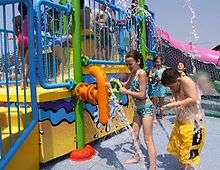
| Froster Soak City | |
|---|---|
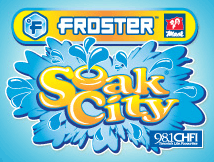 | |
| Location | Ontario Place, Ontario, Canada |
| Owner | the Crown in Right of Ontario |
| Opened | 1978 |
| Closed | 2012 |
| Pools | A single pool |
| Water slides | 5 water slides |
Froster Soak City was the water park located in the Ontario Place theme park before its closure.
The waterpark began with a concrete waterslide, Canada's first, opened in 1978 on the East Island infill. It was expanded with new water attractions (Hydrofuge in 1993 and Rush River Raft Ride, Pink Twister waterslide and Purple Pipeline waterslide in 1995) and eventually to the current Soak City theme in 2001.[6] In the Splash Pad area of the park, many of the features are interactive and controlled by user-operable valves. The valves are free-turning ball-valves connected to large handwheels.
Attractions
- Hydrofuge - open 1993
- Lakeside Beach Spa Pool
- Pink Twister - open 1995
- Purple Pipeline - open 1995
- Rush River - open 1995
- Topsy Turvy - open August 2011
- Tipping Bucket
- Splash Pad
Former attractions and venues
- HMCS Haida is a decommissioned Second World War destroyer that was open to the public. In the early 1960s, the ship was going to be scrapped, but volunteers raised enough money to have it saved and towed to Toronto. It opened as an attraction in August 1965 at the pier on York Street. The city had planned to build a 'Serviceman's Memorial Park' near Prince's Gates at Exhibition Place. When the organization 'Haida Inc.' ran into financial problems, the ship was taken over by the Government of Ontario and moved in 1970 to the Ontario Place site, where it was turned into an attraction. It was also used as a Sea Cadet training camp. In 2002, it was bought by Parks Canada and taken to a new home in Hamilton, Ontario and incorporated into a new marine museum in that city.
- The Forum was an outdoor concert venue that was an architectural landmark torn down to make way for the Molson Amphitheatre: it featured covered seating under a unique tent-like, metal framed, solid roof, with extra seating on the open surrounding, grassy hills. While having only half the seating capacity of the current Amphitheatre, it had (arguably) better sound, bench seating, and offered a far more intimate theatre in the round experience; featuring a rotating stage which gave every seat in the house, in turn, an excellent view. It also had the benefit of being generally free with park admission. Featured events included an annual Toronto Symphony rendition of Tchaikovsky's 1812 Overture, complete with the firing of the guns from the nearby HMCS Haida, and often performances by well established acts, such as BB King, Glen Campbell, Kenny Rogers, Johnny Cash, Dizzy Gillespie, Pat Metheny and Canadian acts like Lighthouse, Bruce Cockburn, The Nylons, Luba, James Brown, Men Without Hats, Doug and the Slugs, Parachute Club and Red Rider. Unfortunately, due to a riot by Teenage Head fans in 1981 (purportedly instigated by their manager, who allegedly was interested in the publicity) harder rock acts were thereafter banned from the venue. In summer of 1983, the Forum was ahead of the curve by bringing in acts like Paul Young and the Royal Family and Tina Turner just before her huge comeback the following year.
- "Future Pod" opened in 1982 in Pod 5, featuring displays and exhibits in technology, communications and energy, including a full-sized replica of the Canada Arm.
- The Canadian Baseball Hall of Fame and Museum originally opened in Ontario Place before moving to its permanent home in St. Marys, Ontario.
- "Ontario North Now" made up the bulk of the west island, including the wilderness adventure ride, a simulated mine, and Muskeg Pete's Main Street. The mine exhibit became a weather exhibit in the 2000s.
Final attractions
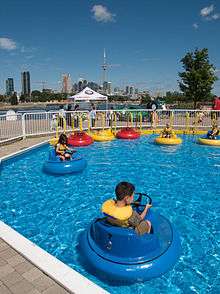
- East Island
An acrobatic stage show, within the Heritage Square, played for part of the final season. Numerous midway rides were temporarily installed at the park in its final season.
- Power Wheels – This ride was closed in June 2011, early in the final season of the first era of the park.
- Cyclone
- Mini Bumper Boats
- First Flight
- Free Fall
- Tilt-A-Whirl
- Mini Greens (mini golf)
- Super Slide
- 4D Ontario
- Cyclone Speedway
- Aquajet Racers
- Froster Soak City
- Waterplay Splash Pad
- Marina Village
- Cinesphere in IMAX 3D
- Atlantis – Restaurant/Club
- OP Driving School
- Bumper Boats
- Cool Hoops – Closed as of June 2011
- Marina with Lake Ontario access
- Boat School
- Eco-learning center
- Earth Ranger
- Mega Bounce
- OP Driving School
- Wacky Worm – Ontario Place's first roller-coaster
- West Island
- Wilderness Adventure ride
- 3D F/X Adventure Theatre
- National Helicopters
- Megamaze
- The Go Zone
- Treehouse Live! Waterfall Stage, previously on the East Island
Redevelopment
2010 request for information
In the summer of 2010, the provincial government issued a Request for Information calling for ideas from private bidders to completely redevelop the park. Ontario Place general manager Tim Casey told the Toronto Star that "2011 will be our 40th anniversary. It definitely needs a revitalization, that’s no surprise. It’s a blank slate, we’re open to just about anything.”[7] A formal Request for Proposals process began that fall. The government intends to transform the park from a largely seasonal facility to a year-round attraction. Redevelopment was to have included the tearing down of the Cinesphere as well as other long standing attractions.[7]
2012 closure
On February 1, 2012, the government announced that the public sections of the park would be closed and redeveloped, which was completed in 2017, in time for Canada’s 150th anniversary. John Tory was announced as the chair of a Minister’s Advisory Panel on Revitalization.[8] All Ontario Place facilities were closed except for the marina, the Molson Canadian Amphitheatre, the Atlantis entertainment venue and parking.[9]
2014
Following the provincial elections in June, the government announced the plans in July for Ontario Place to be developed as an urban parkland with Molson Canadian Amphitheatre, Cinesphere and the pods retained.[10]
2015
The West Channel at Ontario Place was a venue for the 2015 Pan American Games (Athletics -marathon/race walk, cycling (road race), triathlon (cycling/run), open water swimming, triathlon (swim), water skiing and 2015 Parapan American Games (Cycling). Minor and temporary upgrades were made to accommodate use during the games. Construction was begun in March on the park and a waterfront path, which was named the William G. Davis Trail, after the Ontario premier who opened the original Ontario Place in 1971.[11]
2017
Portions of the East Island have been transformed from a parking lot into Trillium Park and the 1.3 km (0.81 mi) William G. Davis Trail, which opened in June 2017.[12]
Opening facts and figures
- Construction start date: March 17, 1969[13]
- Opening day: May 22, 1971[13]
- Total cost: $29,000,000 (Canadian funds, not adjusted for inflation)
- Client: Ontario Department of Trade and Development
- Architects: Craig, Zeidler; Strong
- Structural Engineers: Gordon Dowdell Associates
- Landscape Architects: Hough, Stansbury and Associates
- Contractor: Secant Construction
- Initial park size: 360,000 m² (96 acres), 206,000 m² (51.4 acres) created by landfill[13]
- First-year admission price: $1.00 Adults, $0.50 for Children
- Seating: The Forum: 8,000, Molson Amphitheatre: 16,000
- Attendance: 2.5 million (1971), 1 million (2009)[7]
In popular media
Ontario Place served as a filming location for the episode Angel Of Death from the TV series War Of The Worlds in which it was the setting for the shootout at the end of the episode where Dr Harrison Blackwood, his team, and a supposed alien ally confront the evil aliens which are personally led by the alien advocacy.
See also
References
- ↑ Bradbeer, Janice. "Will this lakeside gem glisten again?"]. Toronto Star, May 15, 2016. page IN7
- ↑ "Ontario Place Revitalization: Minister's Advisory Report" (PDF) (pdf). Ministry of Tourism. p. 2.
- ↑ Modern Canadian Architecture. p. 159. ISBN 0-88830-248-7.
- ↑ Canadian inflation numbers based on Statistics Canada. "Consumer Price Index, historical summary". Statistics Canada. Retrieved April 26, 2018. CANSIM, table (for fee) 326-0021 and Catalogue nos. 62-001-X, 62-010-X and 62-557-X. And "Consumer Price Index, by province (monthly) (Canada)". Statistics Canada. Retrieved April 26, 2018.
- ↑ Dar, Ali (February 15, 2012). "No fun this summer at Ontario Place". Toronto Observer. Retrieved September 14, 2015.
- ↑ http://www.myontarioplace.com/en/ontario_place_history.html Archived September 5, 2010, at the Wayback Machine.
- 1 2 3 "Ontario Place to be torn down and rebuilt", Toronto Star, July 15, 2010
- ↑ "Minister's Advisory Panel on Ontario Place Revitalization". Ontario Ministry of Tourism, Culture and Sport. Queen's Printer for Ontario. Retrieved November 1, 2013.
- ↑ "Parts of Ontario Place to be closed for overhaul". 680 News. 1 February 2012. Archived from the original on 31 March 2012. Retrieved February 1, 2012.
- ↑ http://www.citynews.ca/2014/07/31/tourism-minister-to-provide-update-on-ontario-place-future/
- ↑ Bradbeer, Janice. "Will this lakeside gem glisten again?". Toronto Star, May 15, 2016. page IN7
- ↑ https://www.thestar.com/news/queenspark/2017/06/19/revitalized-section-of-ontario-place-finally-reopens.html
- 1 2 3 History of Ontario Place Archived May 26, 2010, at the Wayback Machine.
External links
| Wikimedia Commons has media related to Ontario Place. |
- Ontario Place
- Ontario Place Revitalization
- Ontario Place Revitalization report (PDF)
- Theme from Ontario Place – A side
- Theme from Ontario Place – B side
- Promotional video for Ontario Place, 1971, Archives of Ontario YouTube Channel
.svg.png)